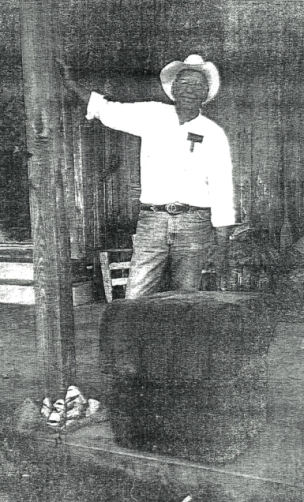| |
Joe D. Hawes has found all kinds of interesting things on Matagorda Island over the years. Sometime back, Mrs. Hawes had told me about two bales of rubber from the Mexican freighter "Qax-aca" that they have setting on the porch of their house at Port O'Connor, and reading a recent news article about some diving at the site of the sunken ship this summer by students from Texas A&M University as part of the Texas Historical Commission's Matagorda Bay Project, I was again reminded of just how close World War II got. About seven to eight miles from the jetties off Matagorda Peninsula, at the 10-fathom line; during the early morning hours of Sunday, July 26, 1S42, the German submarine U-171 sent the 4,350-ton ship to the bottom of the Gulf.
The ship was a former German freighter that had been confiscated by Mexico.
Among the cargo was a shipment of rubber, each bale weighing about 250 pounds, and Hawes found two of the bales washed up among the sand dunes on Matagorda Island some 25 or so years ago possibly left there by the high waters of Hurricane Carla in 1961.
He knows of yet another bale still on the island. His family owned a good portion of the island before it was taken for the Matagorda Island Bombing and Gunnery Range, and they carried on a longstanding battle with the government in the years since, having never been given an opportunity to reclaim their land, which is now under jurisdiction of the Interior Department.
The family did have leasing rights to a portion of the island for grazing, however, from 1947 to 1991, and Hawes spent a lot of time there.
His family roots on Matagorda Island go back to Judge Hugh W. Hawes, who came from Kentucky in 1838, foreseeing the natural pass between the island and peninsula as having a potential for development of the area rivaling that of New Orleans.
A bonded warehouseman, he built a warehouse at Saluria Bayou, near where Fort Esperanza was located later during the Civil War.
In their ranch house at Tivoli, Mr. and Mrs. Hawes have a fireplace built with bricks collected on the island, likely some dating back to his great grandfather's time and that of other Matagorda pioneers.
The Hawes also have a bar made from a mahogany log that showed up at Mule Slough after the 1945 storm.
The island has long caught the debris of Gulf storms and items like the rubber from the "Oasaca" make interesting finds, the bales being the only existing cargo from the ship.
Some of the rubber, I've been told, had been salvaged and taken to Victoria's Foster Field after the sinking.
Hawes, who was away from home as a pilot in the Air Corps at the time, said he has heard that the ship also carried a cargo of creosote pilings. One who saw the flash of the sinking, Arthur Barr, who was a keeper at the lighthouse on the island, just last year told me of some watertight drums that were on the vessel, which he was told contained a white powder used hi the refining of oil for aircraft
The cargo also included some light oil in small barrels placed within larger oak barrels.
While the crew came ashore on Matagorda Island after abandoning ship, Barr recalled that one was killed when the torpedo hit beneath the main hatch on which the man had been sleeping.
|
|
 |
Henry's
Journal
|
|
|
Henry
Wolff Jr.
|
Several years ago, a member of the Sharkhunters, an international organization whose members collect and preserve U-boat history, sent along some information on U-171, a 253-foot German submarine that carried 22 torpedoes and was commanded at the time by a "Kapitan Pfeffer." Barr recalls hearing that the freighter had left Freeport for South America without benefit of convoy and was sailing without lights.
The Mexican crew had spotted the submarine's lights at a distance, but "thought they were being convoyed" rather than being stalked.
Convoying was common since German submarines were active in the Gulf at the time, and two Mexican tankers had been sunk on June 27 in the Bay of Campeche.
U-171, incidentally, would later be sunk by a mine off the coast of France.
The shipwreck is on charts and has long been a popular fishing spot in the Gulf, and Hawes was recalling how the late Clyde Bauer liked to fish that spot and would anchor a buoy there only to have it removed by other fishermen who had navigational equipment and didn't want the spot marked.
Hawes would fly over and drop a buoy so Bauer could find it.
"You can see the wreckage from the air," he says.
After recent dives on the wreck by members of a scientific diving class from Texas A&M University at Galveston, state marine archaeologist Barto Arnold said some wreckage is about 42 feet from the surface.
The remains of the ship are encrusted with sea life and coral. The U.S. Navy had set off charges on the wreckage so it wouldn't be a hazard to navigation.
Today, other than for being a good fishing spot, the "Oaxaca" is just a rusting reminder of how
close the war came to our shores. There and elsewhere.

Joe D. Hawes stands by two bales of rubber that were part of the cargo of the Mexican freighter "Oaxaca" when it was sunk by a German U-boat off Matagorda Peninsula in 1942.
|
|